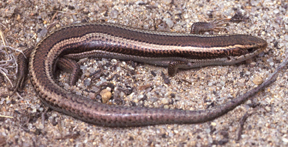Eumeces
|
|
| Eumeces | ||||||||||||||
|---|---|---|---|---|---|---|---|---|---|---|---|---|---|---|
 Western Skink (Eumeces skiltonianus) | ||||||||||||||
| Scientific classification | ||||||||||||||
| ||||||||||||||
| Binomial name | ||||||||||||||
See text
|
The genus of Eumeces-skinks is due to Wiegmann, 1834. They are secretive, agile lizards with a cylindrical body covered with smooth, shiny scales.
The genus sometimes goes by the common name of "New World Skinks" or "Great Skinks" (from Greek: the prefix "eu" means "true" or "good", "mokos" means "size" or "length"), but both these common names are actually misnomers: skinks of the genus Eumeces occur also in Asia, and they're not particularly big either: while the largest skinks of this genus, the Great Plains Skink, can reach a length of some 34 cm or about 14 inches, most species are smaller than 20 cm including the tail. The tail makes up for about half of this total length.
Another colloquial name of these skinks is "blue-tailed skink": young Eumeces often have a brightly colored tail, which is typically blue. In most species, this coloring is lost when the animal reaches adulthood, but a few species retain the color even as adults, e.g. the Bluetail Mole Skink.
This coloring is a survival trait: it attracts a predator's attention to the tail of the animal, which will break off when grabbed. A skink thus often manages to escape and hide under some rock, log, or fallen leaves while the predator still contemplates the wildly thrashing severed tail. (This is an instance of what is called autotomy: voluntarily shedding a body part in order to escape.)
The skink regrows an autotomized tail, which then usually has the same color as the rest of the body and typically is also shorter than the original tail. In some species, regrown tails are pinkish. A regrown tail has a cartilaginous rod for support instead of vertebrae.
Eumeces are all oviparous. The female lays eggs once a year after the breeding season in spring. The clutch size varies and is typically around 5 to 10 eggs. The hatchlings appear in late summer.
Like other reptiles, these skinks are "cold-blooded" — they are ectothermic animals: their metabolism cannot regulate their body temperature. To warm up, they often bask in the sun. In colder climates, they hibernate in winter in burrows below the frost line. In hot climates, they are active mainly in the morning and evening, staying under cover during the hottest hours of the day to avoid overheating.
These skinks are not dangerous to humans. They are not especially aggressive, but will bite if provoked. The bite is not very painful, even to children, who may find great amusement with the spectacle of a lizard dangling from their forefinger. Whether the skink finds this experience amusing as well is doubtful. Eumeces are delicate animals whose tail breaks off easily, and herpetologists and other enthusiasts should handle them with great care, if at all.
Classification
Within the genus Eumeces, the following species are recognized:
- Eumeces anthracinus — Coal Skink; North America
- Eumeces barbouri — Barbour's Skink; Japan
- Eumeces brevirostris — Short-nose Skink; Mexico
- Eumeces callicephalus — Mountain Skink; North America
- Eumeces capito
- Eumeces chinensis — Chinese Skink; East Asia: China, Korea, Japan
- Eumeces colimensis — Mexico
- Eumeces copei — Mexico
- Eumeces coreensis — Korean Skink; Korea
- Eumeces dugesii — Mexico, rare
- Eumeces egregius — Mole Skink; Florida
- Eumeces elegans — Five-striped blue-tailed Skink, Shanghai Skink; East Asia
- Eumeces fasciatus— Common Five-lined Skink; North America
- Eumeces gilberti — Gilbert's Skink; North America
- Eumeces inexpectatus — Southeastern Five-lined Skink; North America
- Eumeces kishinouyei — Kishinouy's Skink; East Asia
- Eumeces lagunensis — San Lucan Skink; Baja California, Mexico.
- Eumeces laticeps — Broad-headed Skink; North America
- Eumeces latiscutatus — Japanese Skink; Japan
- Eumeces liui — Asia
- Eumeces longirostris — Bermuda Rock Skink; Bermuda; endangered
- Eumeces lynxe — Oak Forest Skink; Mexico
- Eumeces marginatus — Ryukyu five-lined Skink; Okinawa and Amami Islands
- Eumeces multilineatus
- Eumeces multivirgatus — Many-lined Skink; North America
- Eumeces obsoletus — Great Plains Skink; North America
- Eumeces obtusirostris — Original name of Eumeces septentrionalis obtusirostris
- Eumeces ochoterenae
- Eumeces okadae — Okada's five-lined Skink; Japan
- Eumeces parviauriculatus — Northern Pygmy Skink; Mexico
- Eumeces parvulus — Southern Pygmy Skink; Mexico
- Eumeces popei — Asia
- Eumeces quadrilineatus — Four-lined Asian Skink
- Eumeces septentrionalis — Prairie Skink; North America
- Eumeces skiltonianus — Western Skink; North America
- Eumeces stimpsonii — Yaeyama seven-lined Skink; Japan
- Eumeces sumichrasti — Mexico
- Eumeces tamdaoensis
- Eumeces tetragrammus — Four-lined Skink; North America
- Eumeces tunganus
Some species that originally were considered Eumeces have recently been assigned to other genera:
- Eumeces algeriensis — North Africa: Novoeumeces algeriensis
- Eumeces altamirani — Mesoscinucs altamirani
- Eumeces blythianus — Novoeumeces blythianus
- Eumeces indothalensis — Eurylepis indothalensis
- Eumeces managuae — Mesoscinucs managuae
- Eumeces poonaensis — Eurylepis poonaensis
- Eumeces schneideri — Berber Skink, North Africa: Novoeumeces schneideri
- Eumeces schwartzei — Mesoscinucs schwartzei
- Eumeces taeniolatus — Eurylepis taeniolatus
Finally, there is Eumeces gaigeae, the "Variable Skink" in North America: researchers seem to be unclear about this skink, it is sometimes listed as a separate species, and sometimes as a subspecies of Eumeces multivirgatus, either as Eumeces multivirgatus gaigeae or as Eumeces multivirgatus epipleurotus.
